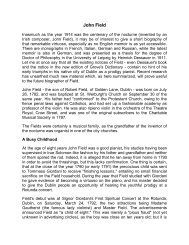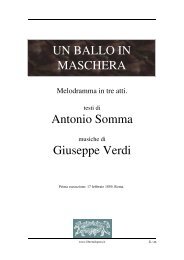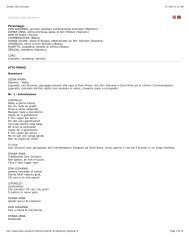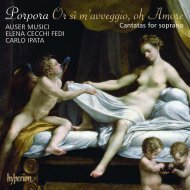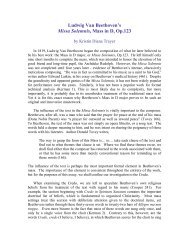Young People's Concerts - What is Sonata Form? - Fulmini e Saette
Young People's Concerts - What is Sonata Form? - Fulmini e Saette
Young People's Concerts - What is Sonata Form? - Fulmini e Saette
Create successful ePaper yourself
Turn your PDF publications into a flip-book with our unique Google optimized e-Paper software.
Bernstein's Studio - <strong>Young</strong> <strong>People's</strong> <strong>Concerts</strong> - <strong>What</strong> <strong>is</strong> <strong>Sonata</strong> <strong>Form</strong>?<br />
02/25/2007 11:23 AM<br />
[SING: Lennon/McCartney - And I Love Her]<br />
Well, that's a small step forward from Twinkle, Twinkle, Little Star, it's small, but it's a step. It's grown in size, and it has that extra deluxe feature--the<br />
repeat of the first A section, which Twinkle, Twinkle does not. Now let's follow the growth of a three-part song even further, as it expands into a big<br />
operatic aria--for example, the famous aria from Carmen that <strong>is</strong> sung by the other woman, Micaela. Th<strong>is</strong> <strong>is</strong> a little more soph<strong>is</strong>ticated; it doesn't break<br />
up quite so neatly into an exact A-B-A but I'm sure you'll be able to follow its three parts, just as easily as the Beatles song: the sweet, lyrical first part<br />
the more excited and dramatic middle part, and the return again to the quiet first part. And here to sing it for us <strong>is</strong> M<strong>is</strong>s Veronica Tyler, who made her<br />
telev<strong>is</strong>ion debut on one of our <strong>Young</strong> Performers <strong>Concerts</strong> just a few years ago. We're delighted to have her back with us again singing Micaela's aria<br />
from Carmen.<br />
[ORCH: Bizet - Carmen: Micaels's Aria]<br />
Well, now that we have learned to recognize a three-part song form, which I'm sure we have, I think we're ready to take the plunge into sonata form<br />
itself. Because a typical sonata movement <strong>is</strong> really only a more expanded version of a three-part form, even to the balancing of its two A-sections on<br />
either side of the central B section. And here's where those nasty road map names come in -- I'm sorry but they have to: the first part, or A-section <strong>is</strong><br />
called the exposition: th<strong>is</strong> <strong>is</strong> where the themes of the movement are stated for the first time--or exposed, if you will: therefore the word exposition. Th<strong>is</strong><br />
<strong>is</strong> then followed by a B section, in which one or some or all of those themes are developed in different ways; and so it <strong>is</strong> called the development<br />
section. And finally, just as you expected, we get the A section stated again; and th<strong>is</strong> third part <strong>is</strong> usually called--watch out!-- the recapitulation. Wow,<br />
that's a tough one. Actually, I'm not too crazy about those terms, either but what can we do? We have to use the words that are most commonly used<br />
in order to be understood; so I guess we're stuck with those words - exposition, development, and recapitulation for our A-B-A.<br />
But whatever words we use, the idea of the three parts <strong>is</strong> still clear and simple; the feeling of balance we get from two similar sections situated on<br />
either side of the central development section, just as the ears are situated in a balancing position to the nose. But you remember I said that there<br />
were two main secrets to the sonata; balance, and contrast. And th<strong>is</strong> idea of contrast <strong>is</strong> just as important as the other idea of balance; it's what gives<br />
the sonata form its drama and excitement.<br />
[TO PIANO]<br />
Now how does th<strong>is</strong> contrast take place? I'll show you; and here we're going to have to get technical for a minute or two. But I'm sure you won't mind<br />
that; because what I'm going to show you now <strong>is</strong> very important--in fact th<strong>is</strong> <strong>is</strong> the root of th<strong>is</strong> whole sonata business. And that <strong>is</strong> the sense of key, or<br />
tonality. Most music that we hear <strong>is</strong> written in one key or another; not so much the concert music that's written these days, but most of the music you<br />
are likely to hear <strong>is</strong> written in a key. For instance, the Beatle song we played before <strong>is</strong> in th<strong>is</strong> key:<br />
[SING: Lennon/McCartney - And I Love Her]<br />
That's F-major. But it could also be in G-major:<br />
[SING: Lennon/McCartney - And I Love Her]<br />
Or it could be in C-major:<br />
[SING: Lennon/McCartney - And I Love Her]<br />
or in any of twelve other different major keys. Not twelve others, twelve in all. But whatever key it's in--let's say C-major--you feel a key-note, a<br />
center, or home plate, where the music belongs, starts out from there, and gets back to. That home plate center <strong>is</strong> called the tonic.<br />
[PLAY]<br />
The tonic note <strong>is</strong> the first note of the scale,<br />
[PLAY]<br />
and the tonic chord <strong>is</strong> the chord you build on to that note.<br />
[PLAY]<br />
Now all the other notes of the scale also have names; but I won't bother you with them except for th<strong>is</strong> one, which I'd like you to remember: the<br />
dominant. That's the name given to the fifth note of any scale--<br />
[PLAY AND COUNT]<br />
1, 2, 3, 4, 5 --in th<strong>is</strong> key of C-major the fifth note happens to be G<br />
[PLAY]<br />
and the dominant chord <strong>is</strong> the chord that's built on that note.<br />
[PLAY]<br />
That's the dominant. Now comes the main event--how these two key-centers, the tonic and the dominant, are related to each other. If I play a tonic<br />
and a dominant chord, in that order, what do you feel?<br />
[PLAY]<br />
Something <strong>is</strong> left unfin<strong>is</strong>hed, unresolved, <strong>is</strong>n't it? You feel a desperate urge to get back to the tonic, where you started, don't you?<br />
Okay--let's play them in reverse order--dominant to tonic<br />
[PLAY]<br />
and now you feel sat<strong>is</strong>fied, don't you? So you see, that tonic <strong>is</strong> like a magnet; you can pull away from it, going to all kinds of other chords,<br />
[PLAY]<br />
other keys, or tonal centers; but in the end the tonic always pulls you back.<br />
[PLAY]<br />
And out of th<strong>is</strong> magnetic pull, away from and back to the tonic, classical sonata form <strong>is</strong> built. That's where the drama lies, the tension--in the contrast<br />
of keys with one another. Let's see how th<strong>is</strong> works in an actual piece of music by Mozart.<br />
The composer will naturally begin h<strong>is</strong> sonata in the key of the tonic, and h<strong>is</strong> opening theme will be in that key, as in th<strong>is</strong> famous C-major <strong>Sonata</strong> by<br />
Mozart. Here's the main theme.<br />
[PLAY: Mozart - <strong>Sonata</strong> in C major]<br />
But now, like a magician, he begins to lure us away from the tonic to a new key--the dominant.<br />
[PLAY: Mozart - <strong>Sonata</strong> in C major]<br />
There we are in the dominant key--G-major.<br />
[PLAY: Mozart - <strong>Sonata</strong> in C major]<br />
And in th<strong>is</strong> new key Mozart gives us a new theme, h<strong>is</strong> second theme, which goes like th<strong>is</strong>:<br />
[PLAY: Mozart - <strong>Sonata</strong> in C major]<br />
and then finally, still in the key of G-major, he gives us a little fanfare-like tune with which he closes the exposition.<br />
[PLAY: Mozart - <strong>Sonata</strong> in C major]<br />
So there we are, solidly establ<strong>is</strong>hed in the dominant key of G-major and the exposition part of th<strong>is</strong> movement <strong>is</strong> over.<br />
Now at th<strong>is</strong> point in the classical sonata we usually bump smack into a repeat sign, which means go back to the beginning and play that whole A<br />
Section or exposition you have just heard, all over again. Just like the Beatles: Remember? A-A-B-A. You repeat that phrase. And so for the second<br />
time, we hear the full exposition - first theme, second theme, and closing theme; starting in the tonic and winding up in the dominant. But there's no<br />
point in playing it for you now. You've all just heard it. So you go on to the next section.<br />
Actually th<strong>is</strong> whole exposition we've just heard <strong>is</strong> like a drama, the drama of running away from home--a pulling away from that magnet we call the<br />
tonic. Now the next act coming up, the development, intensifies that drama, wandering even farther away from home, through even more d<strong>is</strong>tant keys,<br />
but then finally giving in and coming home in the third act--or recapitulation. That's the drama of it all. So in the second part, or development section of<br />
th<strong>is</strong> Mozart sonata, the composer lets h<strong>is</strong> imagination roam free; the themes he has stated in the exposition wander around in one foreign key after<br />
another--like a trip around the world. Now because th<strong>is</strong> particular sonata of Mozart's <strong>is</strong> a very short one, the development section <strong>is</strong> also very short. In<br />
fact the only theme Mozart does develop <strong>is</strong> that little fanfare tune we just heard--the closing theme of the exposition<br />
[PLAY: Mozart - <strong>Sonata</strong> in C major]<br />
but now in the development, he puts it through its paces...like th<strong>is</strong>.<br />
[PLAY: Mozart - <strong>Sonata</strong> in C major]<br />
Which brings us to the third and last section of th<strong>is</strong> three-part sonata form--the recapitulation. And th<strong>is</strong> <strong>is</strong> the moment when that magnet we were<br />
http://www.leonardbernstein.com/studio/element2.asp?id=401<br />
Page 2 of 3




